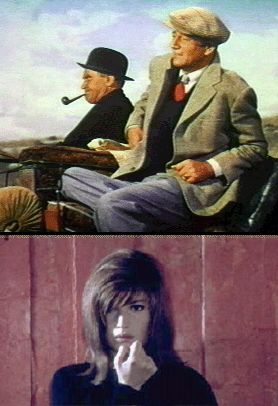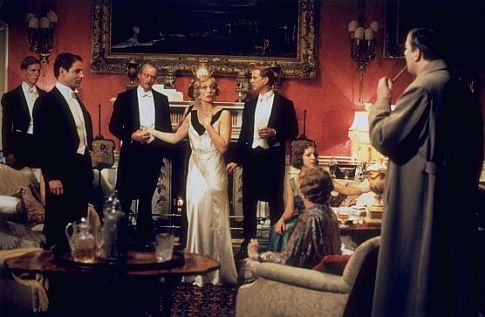
Mise-en-Scène: "Slow Down! You Move Too Fast!"
 |
||||
| Ford and Antonioni both displayed a painterly instinct for mise-en-scène, as is evident in their respective works, The Quiet Man (top) and Red Desert. | ||||
All of film dialectics recall the initial division between the Lumière brothers and Georges Méliès: the Lumière brothers were the realists; Méliès was the expressionist. The Lumières favored mise-en-scène, Méliès montage. To this day, a belief in pure mise-en-scène has been associated with realism while montage has been the tool favored by expressionists. There are great filmmakers on either side of the debate.
Roberto Rossellini, the Italian neorealist, was fascinated with the power of mise-en-scène throughout his career. Rome, Open City (1946) and Paisan (1947) did much to re-establish the esthetic of realism. They are both breathtaking collections of dramatic compositions. Later, near the end of his career, Rossellini was responsible for a remarkable series of historical portraits in which he took the concept of mise-en-scène in new directions by using painted backdrops and a matte system of his own devising to create historical settings inexpensively. It is not surprising, really, that filmmakers who love the work of mise-en-scène are also painters.
Federico Fellini, who quickly transcended neorealism, began as a cartoonist - indeed, sine of his greatest films (La Dolce Vita, 1959; 8 1/2, 1962) draw much of their power from the cartoon aspects of their mise-en-scène. Their galleries of grotesque or otherwise striking characters are reminiscent of Daumier or Goya. And the simple strength of the widescreen compositions is also evocative of the cartoon esthetic.
John Ford wasn't a painter - his instincts were literary - but his love of the American west inspired his painterly mise-en-scène, and that affinity carried over into his nonwestern films. Any good western is a masterpiece of mise-en-scène. It has to be! If you don't love the vistas - the "scène" - why make a western? Indeed, the idea of the western turns mise-en-scène into a philosophy: western stories are about the relationship of characters to that remarkable setting.
Mise-en-scène isn't only painterly - it is theatrical, as well. That is where the term originated. So any filmmaker with roots in theatre very likely evinces a love of mise-en-scène. Perhaps one way to look at these two approaches to mise-en-scène is to compare filmmakers' attitudes toward character. If they feel close to their characters and their drama, the mise-en-scène is likely to be more theatrical: your attention is going to be on the people in the scene. If they take a more distant approach to characters, using them as elements in a composition, that's likely to be more static and more painterly. Your attention is drawn to the design.
Michelangelo Antonioni was notorious for using actors as props - design elements. The result was great painterly mise-en-scène, as for example in Red Desert (1964). Stanley Kubrick was also known for his distant approach to character. That should be clear from 2001: A Space Odyssey - lots of great shot design, but HAL the machine shows more human emotion than any of the people in the film.
 |
||
| Altman's Gosford Park is a prime example of successfully blending painterly and theatrical mise-en-scène. This shot, for example, balances the importance of the characters' actions with the lushness of the image. | ||
Please note that these approaches are not mutually exclusive any more than montage and mise-en-scène are exclusive. Robert Altman's Gosford Park (2001) comes immediately to mind as a wonderful balance of painterly and theatrical mise-en-scène.
Of course, an aversion to montage can be overdone. As an experiment, Alfred Hitchcock shot the film Rope (1948) in one apparent take - no cuts. (Because film cameras at the time held only about 10 minutes of film, he had to fudge the transitions between reels. What the viewer saw appeared seamless, however.) Did he re-create the theatrical experience authentically? Probably not. A stage director has other techniques, such as lighting and blocking, to redirect our attention―the functional equivalent of montage in film.
Is a pan more "true" than a cut? Most observers think not. (See the discussion of this question in How To Read a Film, pp 172-173.)
In the end, a film style that concentrates on mise-en-scène tends to reinforce our connection with the characters on the other side of the lens, as well as with the setting. Montage, on the other hand - as you'll see shortly - tends to call our attention to the filmmaker and the art. But remember that these are tendencies - not rigid rules.
A Note About Aspect Ratio
Surprisingly, one important element of mise-en-scène is standardized: aspect ratio. You've already come across a detailed analysis of this subject in your text (pp. 106-112). Right now, it's just important to call attention to two interesting issues concerning aspect ratio.
First, notice how few filmmakers vary the aspect ratio of their films. You'd think that such a basic decision as the size and shape of the frame would be of critical importance to a director - it is to painters (and even to theatre directors). That it is not is likely due to the standardization necessary for projection - as long as they stay within the limits of the movie theater's screen, directors are certainly free to experiment with frame size. They don't do it very often, though, which suggests that the current set of widescreen aspect ratios, approximating as they do the Golden Mean, have a certain psychological rightness to them.
The problem comes with television, which is still stuck with the 4:3 Academy ratio. That is about to change with the introduction of HDTV and its 16:9 ratio, but an entire generation has grown up watching feature films that have been butchered for video with as much as 47 percent of the frame missing! Video distributors try to compensate for this by using a technique called pan and scan. This means that when important information is on the sides of the frame, an artificial pan is made from one side to the other.
The Wonders of Letterboxing
The advent of DVD has done much to improve the situation. Movie buffs now know to get the "letterboxed" version of any film. A letterboxed DVD includes the entire frame the filmmaker intended for you to see, with black borders on the top and bottom to fill the television screen. It is a common misconception that, when given the choice between widescreen and full-frame home versions of a movie, it's better to choose the full-frame one because it has "the whole picture." Nothing could be further from the truth! In fact, many people think that the black bars used in letterboxing mean that something is missing from the picture (by abernathy). In fact, the exact opposite is true. The widescreen version is the one with the entire picture―the one that the director intended you to see. The full-frame or pan-and-scan versions are actually the ones that are often missing parts of the picture. In fact, in a pan-and-scan version of a film, you'll often find that entire people are missing from the screen!
You can do some aspect ration analysis of your own. Using this printable aspect ration gauge (click here to download), you can see what aspect ratio films are presented in. It may be interesting to check the aspect ratio of a film in the theater, and then to check that same film on TV. If the ratio is different on TV, you're probably not seeing the film as the director intended it to be seen.
There are a few films that may survive having their left and right sides lopped off; there are no films that don't improve dramatically with letterboxing. If you are concerned with understanding something like mise-en-scène or montage, and truly want to analyze a film, it's imperative that you see the director's original vision for what it is. Next time you're faced with deciding between widescreen and some other version (if you didn't already do this), be sure to choose widescreen.